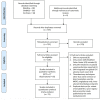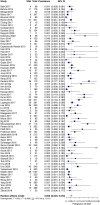Subarachnoid Hemorrhage in Mechanical Thrombectomy for Acute Ischemic Stroke: Analysis of the STRATIS Registry, Systematic Review, and Meta-Analysis
- PMID: 34113310
- PMCID: PMC8185211
- DOI: 10.3389/fneur.2021.663058
Subarachnoid Hemorrhage in Mechanical Thrombectomy for Acute Ischemic Stroke: Analysis of the STRATIS Registry, Systematic Review, and Meta-Analysis
Abstract
Background: The indications for mechanical thrombectomy in acute ischemic stroke continue to broaden, leading neurointerventionalists to treat vessel occlusions at increasingly distal locations farther in time from stroke onset. Accessing these smaller vessels raises the concern of iatrogenic subarachnoid hemorrhage (SAH) owing to increasing complexity in device navigation and retrieval. This study aims to determine the prevalence of SAH following mechanical thrombectomy, associated predictors, and resulting functional outcomes using a multicenter registry and compare this with a systematic review and meta-analysis of the literature. Methods: Data from STRATIS (The Systematic Evaluation of Patients Treated with Neurothrombectomy Devices for Acute Ischemic Stroke) registry were analyzed dichotomized by the presence or absence of SAH after thrombectomy. Only patients with 24-h post-procedural neuroimaging were included (n = 841). Multivariable logistic regression was performed to identify significant predictors of SAH. A systematic review and random-effects meta-analysis was also conducted in accordance with the PRISMA (Preferred Reporting Items for Systematic Reviews and Meta-Analysis) protocol. Results: The prevalence of post-thrombectomy SAH was 5.23% in STRATIS with 15.9% (1.84% overall) experiencing neurological decline. Distal location of vessel occlusion (OR 3.41 [95% CI: 1.75-6.63], p < 0.001) and more than 3 device passes (OR 1.34 [95% CI: 1.09-1.64], p = 0.01) were associated with a higher probability of SAH in contrast to a reduction with administration of intravenous tissue plasminogen activator (tPA) (OR 0.48 [95% CI: 0.26-0.89], p = 0.02). There was a trend toward a higher discharge NIHSS (8.3 ± 8.7 vs. 5.3 ± 6.6, p = 0.07) with a significantly reduced proportion achieving functional independence at 90 days (modified Rankin Score 0-2: 32.5% vs. 57.8%, p = 0.002) in SAH patients. Pooled analysis of 10,126 patients from 6 randomized controlled trials and 64 observational studies demonstrated a prevalence of 5.85% [95% CI: 4.51-7.34%, I 2: 85.2%]. Only location of vessel occlusion was significant for increased odds of SAH at distal sites (OR 2.89 [95% CI: 1.14, 7.35]). Conclusions: Iatrogenic SAH related to mechanical thrombectomy is more common with treatment of distally-situated occlusions and multiple device passes. While low in overall prevalence, its effect is not benign with fewer patients reaching post-procedural functional independence, particularly if symptomatic.
Keywords: direct aspiration; endovascular therapy; ischemic stroke; large vessel occlusion; stent retriever; subarachnoid hemorrhage; thrombectomy.
Copyright © 2021 Lee, Qureshi, Mueller-Kronast, Zaidat, Froehler, Liebeskind and Pereira.
Conflict of interest statement
The authors declare that the research was conducted in the absence of any commercial or financial relationships that could be construed as a potential conflict of interest. The reviewer KK declared a past co-authorship with one of the authors DL to the handling Editor.
Figures







